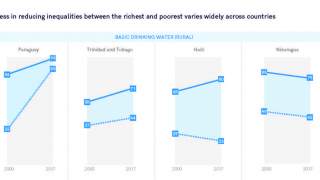In many countries, pronounced inequalities in water, sanitation and hygiene services persist between rich and poor
Inequalities between rich and poor are found in all countries. In those countries where data from national surveys allow for classification of households into asset-based wealth quintiles, it is possible to analyse inequalities in access to drinking water and sanitation between rich and poor. Analysis of trends is particularly important in order to assess whether inequalities in access and service levels are being progressively reduced over time. Wealth quintile data for basic drinking water, sanitation and hygiene are available for around 80 countries.
Wealth quintile method
Based on the findings of a methodological study, the JMP has adopted an approach involving the re-analysis of existing data to remove water, sanitation and hygiene variables from the asset index. Where possible the JMP team has adapted standard wealth quintile analysis scripts from household surveys such as MICS and DHS. Wealth quintile estimates have been prepared for basic drinking water, sanitation and hygiene as well as lower rungs in these service ladders.
The JMP wealth quintile analyses are based on a sub-set of surveys for each country and can differ from the estimates at rural, urban and national levels. Nevertheless they represent information based on nationally representative surveys and are suitable for comparisons across wealth groups and between countries. The estimates are based on wealth quintiles derived from an analysis of household assets, such as electrical goods and materials used for housing construction, and may also differ from those based on income or consumption.
